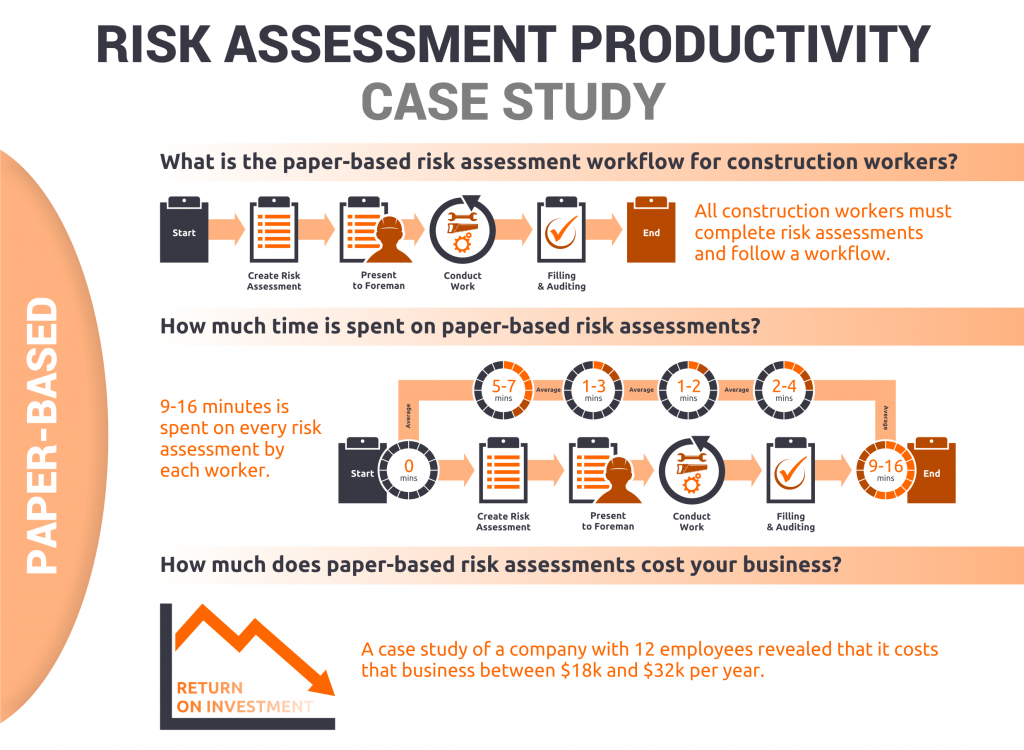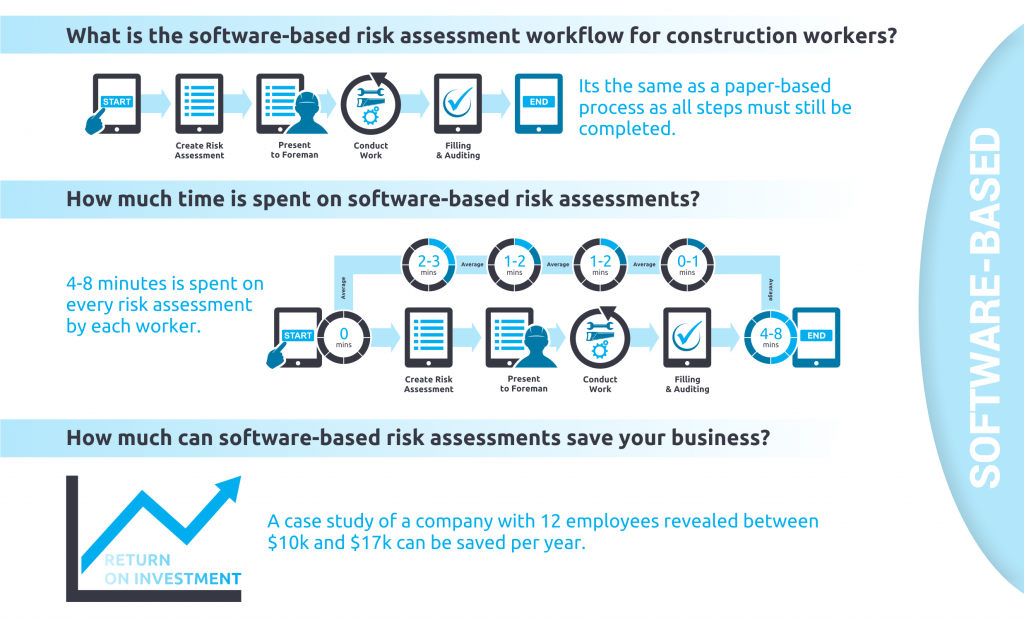How a Simple Process Drives Safety Compliance
Safety management systems have come a long way in the last 250 years. Just think back to workplace conditions during the Industrial Revolution – almost no pay, child labour, very long hours, and extremely dangerous work conditions with exposure to chemicals, accident-prone machinery, and no WHS requirements whatsoever.
But this has changed over the years. Legal reforms and acts were introduced – the Factory Act, the Employer’s Liability Act, and finally, the 1974 Health and Safety at Work Act. This legal document became the foundation for workplace health and safety processes in the UK and the rest of the world. And it led to the increasingly more complex safety processes we have today.
The core purpose of WHS is to keep people safe. Simple. With the increasing complexity of requirements and standards, Business owners, project managers and safety officers alike have to be careful of falling into the trap of using compliance to document requirements like the SWMS as their main measure of WHS compliance. This article looks at why adhering to document requirements is a poor standalone indicator of compliance. We also suggest how a simple safety process drives the success of your WHS compliance.
Documents are Symbols of a Process
Safety isn’t symbolic. It is real and should be treated in the real world, not on a document. Safety management systems do involve documents, but they symbolise a process. For example, a SWMS is a safety planning tool that identifies the risks of high risk construction work and the actions taken to manage those risks. It symbolises the process you are going to take when dealing with the risks and making sure your workplace and its workers are safe from those risks. When it’s under the (judges) hammer, the process symbolised (documented) matters most – not the symbol or the document itself.
Downloading a generic template for your SWMS, JSA, or any other safety document is like taking the symbol without taking the process it represents. And that defeats the whole point of your safety management system and its documents. To comply with WHS requirements, you should be focusing on the processes required to keep your workplace and its workers safe – not just on the documents themselves.
WHS audits look at whether you have followed an effective process that actively reduces the risks in your workplace. They care about if you have actually provided a safe work environment. Not simply whether you have ticked the box of completing a piece of paperwork.
In 2013, The Supreme Court Qld in a case against a QLD construction company for the death of two workers cited:
“work practices focused too much on the work performed onsite and did not pay adequate attention to the dangers presented by the conditions of the site itself”
In other words, not considering risks on the ground, in the real world can have significant impacts when taken to the extremes. Focussing too hard on the details of the tasks to be completed can lead to ignoring all the risks that are actively present
What you focus on matters. And if you want to pass your WHS audit and actually keep your workers safe, then it’s time to focus on the safety management process behind the symbols and documents.
But I still go through a process when filling in a template?
Safety management systems aren’t just about the symbols. They’re about the processes behind them. But you may be wondering – isn’t downloading a generic template still technically a process? Sure. But think about this. What process is more effective at satisfying the Work Health and Safety Act requirement to provide a safe work environment? Is it:
- Find a generic SWMS template on Google, Officeworks or other source
- Complete the boxes provided by the template as best as you can
- Gather up or seek out workers individually and gather signatures
- Store it onsite until the work is done
- Transferring the document to a folder in your office when you are done with the site
Or:
- Identify a the risks onsite, in person
- Build a new SWMS or modify the existing version to cover all task & site-specific risks that are present. Pushed to everyone to sign.
- Monitor how measures are being implemented while work is being completed with real time automated risk rating notifications
- Review by anyone relevant once the work has been completed
- Automatic document storage once complete for any future audits, follow-ups, or learning
From a legal standpoint, the second option is better,
The very purpose of developing a SWMS is to ensure that employers and workers have taken the time to identify the high-risk tasks to be done on site. And then, it is to develop measures to manage these risks and tasks in the context of the work being done. The very nature of a SWMS is that it is specific. It is created specifically in response to a specific site, specific tasks, and specific risks. A generic templated SWMS will not meet the intention behind WHS requirements. Instead, it will defeat the real power of the SWMS and even take away from your safety management.
As WorkSafe Victoria explains, “our concern is not what is written but what actually happens”. A generic SWMS is a symbol of safety that only provides guidance. To focus on the process and comply with WHS requirements, your SWMS and other safety documents need to be customised. It is the second process that is more likely to pass a WHS audit because it demonstrates an active approach to creating a safe work environment. And it is the first process that will get a much more severe punishment when a safety incident does happen, even though both processes are represented by the same type of document.
How to Prioritize the Process
The simplest way to boost the effectiveness of your safety process is to use a digital safety platform like SafeWorkPro. While you can do your safety management physically or digitally, doing it digitally is what will make the difference. Why?
Safety management software simplifies your safety management. Turning a complex process into a simple, easy to understand workflow that allows for an easier way to assess, mitigate, monitor and review workplace risks of all nature. It makes sure that your safety management system is customised, comprehensive, and lets you focus on the process. Leave the document creation, distribution and storage to the software. With safety management software, you can seamlessly customise, prioritise, and ensure your safety management system and its processes exceed WHS regulations.
SafeWorkPro is the Australian safety management software that can make sure your workplace prioritises the process over the symbols.
- Customise your SWMS, JSA, or other safety documents specifically to your worksite using our flexible document builder
- Make sure your specific workplace risks are managed and your workers are safe
- Ensure your company truly complies with WHS requirements
Do all of this seamlessly and in one place with the SafeWorkPro platform. Click the button below to find out more.
More From The SafeWorkPro Blog
Risk Assessment Software: 5 questions to consider
The best way to explain risk assessment software is to look at the advantages it has over the traditional paper-based method. For starters, as any business owner or manager would know, time is money, so a core value of risk assessment software is speed. The easy accessibility of construction safety software makes it instantly superior over the tiresome and time-consuming task of writing a risk assessment on paper. Using construction risk assessment software like SafeWorkPro, you can send a completed risk assessment anywhere at anytime, making compliance with OHS laws and regulations a breeze. But above all, construction safety software keeps your workforce safe and your business in line with risk assessment regulations.
In this article we will outline the 5 stages of risk assessment software in terms of how it works and what it can do for you. But don’t just take our word for it. The below video is the story of Cole Contracting, a small construction business that, when faced with falling productivity and lagging back end administration, looked to risk assessment software for the solution.
For more information on how our construction risk assessment software works, check out the SafeWorkPro Blog. There you’ll have access to all the information you need to get started, plus loads more on how to complete a risk assessment, how to improve productivity and examples of risk assessment forms.
But back to the building risk assessment checklist we think you should consider before signing up to any construction safety software service. These 5 factors will help you evaluate your options and make an informed decision.
1: How much does the risk assessment software cost?
2: Will the software make your workers safe at work?
3: Does the software give you insight into your business?
4: Will the software pass an audit?
5: Does the software help you comply with the Workplace Health and Safety Act?
1: How much does the risk assessment software cost?
The purpose of our software is to ease the problem of automation for risk assessment forms – in other words: to get rid of the paperwork and make the process quicker and easier. In this case, the software does come at a price but it pays for itself through a streamlined risk management process. Consider it more of an investment than a cost. Return on investment (ROI) is the concept of an investment of some resource yielding a benefit to the investor. So, as you are considering what risk assessment software to use, ask each vendor what ROI you can expect from using their software. SafeWorkPro has a calculated ROI of over 200% (learn more about how we calculated that figure here). We are confident that SafeWorkPro will save you time and money.

2: Will the software improve workplace safety?
Ultimately you want your workers to be safe while they’re on the job. So a key question to consider is how can software help with this? For SafeWorkPro’s risk assessment software, safe operating procedures are delivered to workers when they are on the job via a tool they can download to their mobile or tablet device. So when the worker starts to fill out a risk assessment form on their smartphone or tablet, they are presented with data that has been filled out on previous risk assessments. These suggestions mean that workers are provided with the most relevant risk
3: Does the software give you insight into your business?
Everyday construction managers have to deal with safety. It’s a big part of the job and many safety procedures must be followed otherwise strict penalties may apply. Unsafe behaviour can put workers at risk and result in accidents but there is a way that risk assessment software can help managers. Our software has a configurable dashboard that adds all sorts of meaningful graphs and tables allowing managers to identify hazards and plan a risk management process ahead of time. This is huge benefit for any risk assessment plan because time is saved through smarter and more efficient work.
4: Will the software pass an audit?
If you are audited and need to present your safety management plan, risk assessments, and safe work method statements, SafeWorkPro can deliver these documents to anyone at anytime. The federal government’s fact sheet looking into the top ten corrective action reports (CARs) lodged between 2012-1013 documents failed work practices and reflects the strict requirements of current legislation. So, to avoid joining this list, you need to make sure that your software can output all the documentation needed for the audit. Our software will output all risk

5: Does the software help you comply with the Workplace Health and Safety Act?
The general purpose of the Work Health and Safety Act 2011 is to provide a balanced and nationally consistent framework that secures the health and safety of workers and workplaces. When you take a detailed looked at the legislation there are many factors to consider but there are a few general undertones worth mentioning. Firstly, it the duty of the individuals involved in the high risk construction work to manage risks to health and safety. These duties cannot be deferred to someone else. Furthermore, there are certain requirements that must be met or else a penalty could be issued. For example, a principal contractor must be presented with safe work method statements and risk assessments before work on a job can begin. So, the question is how does risk assessment software help with this? Our software allows you to email the appropriate documentation to the principal contractor before starting work. principal contractors find this very convenient as they then have an electronic record in their email inbox to keep and don’t have to worry about filling or document storage down the track.
Summary
There are many factors to consider when evaluating risk assessment software and we’ve touched on a few of the core issues you should think about. That being said, it is our belief that SafeWorkPro satisfies this criteria but if you would like to know more about our risk assessment software please take a look at the SafeWorkPro Blog or drop us a line via our contact page.
SafeWorkPro: getting you on the job quick, safe and compliant.
The Basic Risk Assessment Questions
Understanding OHS laws and regulations is a prime concern for anyone involved in high risk construction work. When done properly, risk assessments make worksites safe and reduce the likelihood of injury or worse. Knowing how to perform a risk assessment is not the only aspect to safe work practices that should be considered. There are other risk assessment questions worth addressing.
What is a risk assessment form?
This basic question has a basic answer. A risk assessment form is a series of documents that aim to identify the risks and hazards evident on a worksite, list the types of high risk construction work involved and outline the measures to be put in place that will eliminate or at least reduce these risks. Risk assessments consist of a safe work method statement and a risk assessment matrix. A safe work method statement is a certified document that must outline what the high risk work is, the risk involved and the control measures to be implemented. Risk assessment matrices place a numerical value on the level of risk associated with each type of high risk work based on their likelihood and consequence.

What is a risk analysis?
This is the process of interpreting just how severe the consequence of a risk or hazard could be. It involves using a risk assessment matrix to place a numerical value on how serve a specific hazard could be. This is done to give workers a better understanding of the risks involved, in turn encouraging safe work practices.
Why do we need risk assessments?
Although they are just another type of paperwork, risk assessments are essentially a way to make safe work practices part of an average worker’s daily routine. By instilling the risk assessment process into the everyday habits of a worker, it is hoped that the type of safe work practices required in any job will be better understood and used more regularly.
Why are risk assessments carried out?
Other than the promotion of safe work practices, risk assessments are carried out as a way to formalise compliance with OHS laws. By having a written record of your risk assessments, regulators are able to check the extent to which a construction business has complied with safe work standards. Also if an accident were to occur, the risk assessment can be used in legal proceedings as a record of compliance. This point underlines the importance of storing risk assessments clearly and efficiently – if you cannot display compliance then you may face penalties.
What is a risk assessment tool?
This is anything that aids or streamlines the risk assessment process. It can take many forms but to date the most efficient method of risk assessment appears to be that offered by software. Risk assessment software takes the paperwork associated with risk management and converts it to a digital form. This basically means that instead of writing a risk assessment on paper, the formwork is completed on an digital tool – like a smartphone app. This is a quicker method of writing a risk assessment but also streamlines the compliance process for managers who, instead of filing paperwork, simple save and store PDF files. Learn more about risk assessment software.
If you would like to learn more about the risk assessment process, check out the SafeWorkPro Blog.
A Risk Assessment Productivity Case Study: how to save time and money
Your business has a problem that you may not even realise exists. It bites way at your productivity, drains your resources and cripples the moral of your workforce. This problem is so embedded into your business model that the prospect of any alternative seems unnecessary and even unpleasant.
In construction, risk assessments are just part of the job. Completing safe work method statements, formulating risk management strategies and then consulting with your workforce is all part of the typical risk assessment workflow. The paperwork is a hassle, filing takes time and compliance requests are just one of those annoyances you have to put up with, right?
Wrong.
You may feel comfortable with the old way of doing risk assessment forms but unfortunately the paper-based method, although tried and tested, is wasteful and costing your business time and money. Whether you’re a business owner, site manager or tradie, risk assessments in the workplace are unnecessarily long and time consuming.
The Problem with the Paper-Based Risk Assessment Process
The sheer number of different safe work method statements (SWMS) in circulation is enough to give you a headache. Organising them all into one place costs money in terms of administrative overhead, not to mention the amount of office space filing takes up. Each worksite is unique and comes with different hazards and risks. Finding the right paperwork for the job takes an almost supernatural sense of premonition. Unfortunately you are not a fortune-teller so predicting how the risks in construction will change as a job develops can throw all your paperwork into a tailspin and render it utterly useless. Also, and let’s be honest here, all this paperwork is just bloody annoying.
Take our risk assessment case study for example. Using an electrical contractor that employees 12 workers, we estimated that our risk assessment software could save this business between $10k to $17k every year. We looked at how much time was spent of paper-based risk assessments and then at how much this process cost. The old saying ‘time is money’, has never been so true but if you’re still not convinced, just check out the below flowchart.

How Risk Assessment Software Can Help
Now all this isn’t to say you should just stick your head in the ground and forget about the risk management process altogether. You could try but sooner or later the regulators would catch up and you’d be facing some pretty serious penalties. Instead it’s time to think about how practical risk assessment software can help you identify risks and neutralise them. Check out just how much quicker the software alternative is below.\

That’s right, technology has the answer but don’t go running for the hills just yet. At SafeWorkPro we’ve developed safety management software that is so simple even your mate’s work dog could figure it out. We’ve achieved this through active consultation with tradies and contractors, not computer technicians who have never even touched a hammer before. SafeWorkPro’s risk management tool can be used on any smart phone or tablet device, and works to streamline the entire risk assessment process. Your safe work method statements are stored digitally – ready to be accessed and implemented into your risk assessment at any point. Then it’s as simple as of scrolling through various options, signing it and sending it away to the manager for storage as a PDF file. All this is done without the hassle of multiple forms or filing, and leaves you with more time to get the job done.
SafeWorkPro gets you on the job quicker, with more safety and in total compliance.



